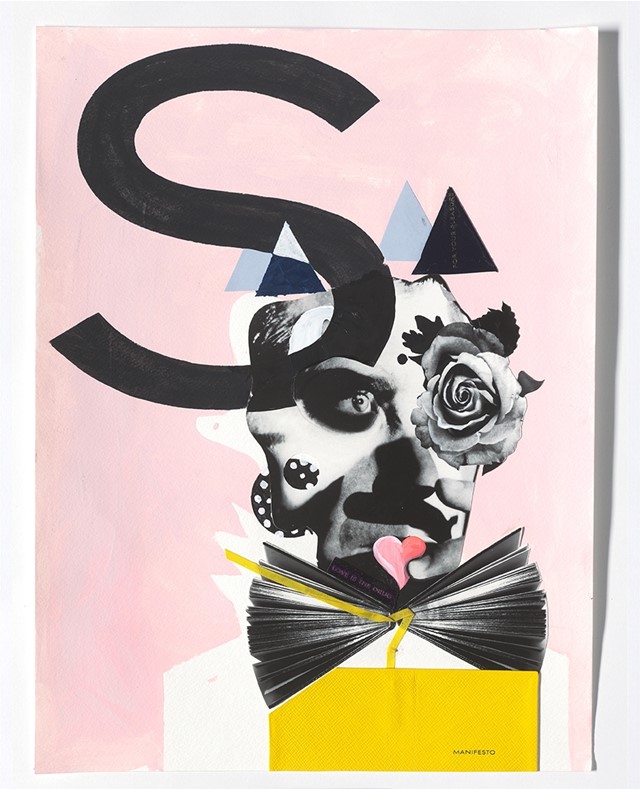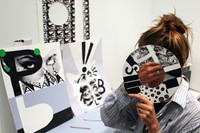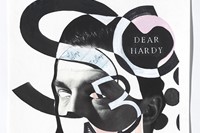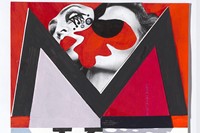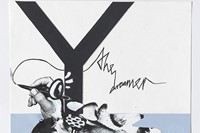Art meets tradition meets leatherwork as Quentin Jones honours Smythson's Panama diary with artworks celebrating ten of its famous fans
Slotted between Mulberry, Margaret Howell and Temperley, Smythson made its debut at London Fashion Week, presenting their S/S14 collection at their newly opened flagship New Bond Street store. It celebrated their Panama diary, collaborating with Quentin Jones to produce a series of ten artworks that each embody a famous fan of the diary, including Hardy Amies, Sigmund Freud, Katharine Hepburn and Dita Von Teese.
Inspired in the early 20th century by the texture and flexibility of the Panama hat – a trademark of the British traveller – Frank Smythson invented the Panama diary in 1908, introducing the world's first portable diary. Each artwork displayed within the exhibition embodies Jones' quirky, surrealist approach incorporating bold lines, pop art references and montaged cut-and-paste aesthetic, with particular reference to masks and eyes, both signature to much of her work. "I felt them particularly relevant for a project on famous faces and minds," explains Jones. "The mask linking to celebrity, or the public face of the private mind, and eyes being classically symbolic of thought. It was fun to see what it could mean to add or take away eyes, put roses or singing mouths where they once were." Here AnOther speaks to Jones about her inspiration for creating the collection of artworks.
How did you approach (artistically) each of the ten high profile figures involved in this project?
The portraits explore not so much the individual's appearance, but more the ideas that surround them, the sort of thoughts they are known for and linking back to what they would use a diary to record. I think it is quite interesting to depict a person through their ideas – ultimately it could all say as much about me than it really does about them; my projection onto them about their own thoughts. Maybe it is all quite circular, but I think it meant creating a series that has quite a lot of variation within it because of the diversity in subjects and how I reacted to them.
Hepburn's portrait (though it is quite hard to make this out!) cuts her face into the outline of a classic movie camera, with the two wheels of film for circular ears, and a tripod for a body. I found a quote from an old film poster of hers for the Desk Set: "Make the office a wonderful place to love in", which I think links back neatly to the diaries and how a beautiful book can allow making notes or sketches to be so enjoyable.
For Freud I turned his face into the wings of a bird type creature, which has a hand and pen for a face. The back of Freud's head, and what comes to be the bird's wings, hold onto globes, and these globes lay below a level of blue. I was thinking about consciousness – what falls below, and the face that exists above it. I love Freud's quote that "the madman is the dreamer awake', and used it as a starting point to the whole picture and, again, felt it tied in nicely with the idea of the diaries.
"I love Freud's quote that "the madman is the dreamer awake' and used it as a starting point to the whole picture"
Do you have a favourite figure within the collection?
I think my favourite image is the one I made of Hardy Amies because it feels quite unlike my usual style of working – it is much neater than I usually am and got me into making more considered patterns in the series. I am usually much more slapdash. It also reminds me of a Paolozzi print my dad has that I grew up staring at.
What was your main point of inspiration for this project?
I was excited to work on this project so I could get away from my computer. I spend so much time making films, taking pictures and editing everything that I find I can spend too much time staring into a screen. My best work is often unplanned, and the temptation with the computer is to test and test things as a way of sketching before you actually put paint to paper – in fear of ruining something. It can be quite creatively restricting, and stop you having a real style. So for this project I really enjoyed just reacting to my ideas on the subjects, cutting and scribbling freely – and seeing what would happen if I just started a pattern without knowing how it would evolve as I drew. I am not sure if this answers the question, but the approach was more influential on the outcome of the images than anything else.
The Panama diary is iconic within the Smythson brand. In your opinion, what has it grown to represent?
To me Smythson is all about rites of passage – friends got given their diaries and beautiful leather goods for their important birthdays or to celebrate successes in their lives. The Panama is also an aspirational product, you instantly recognize and covet the diary. But what really comes to define the diary is the owner and what they write or draw in theirs.
The Panama Legacy is at Smythson, 40 New Bond Street, until September 21.
Text by Mhairi Graham
